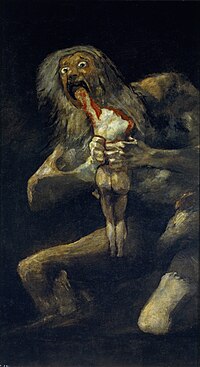Saturn (mythology)
Saturn is a god of agriculture and harvest in Roman mythology. He was identified in Antiquity with the Greek Titan Cronos, frequently intermingling the myths of both. Although Saturn changed greatly over time due to the influence of Greek mythology, he was also one of the few clearly Roman deities who retained elements of his original function.
Myth
Satre was an Etruscan god who appears named on the Liver of Piacenza, a bronze figure used by the haruspices that contains about forty names of divinities in Etruscan; perhaps that is where the name comes from, although it could be, conversely, a mere translation from Latin. Saturn was represented as an old man with a long and thick white beard, with a sickle in his hand. It is the emblem of time and symbolizes it as something very ancient that destroys and ends everything.
The Greeks considered the sky to be the most ancient of the Titans and gave it the name Uranus, homologous to the Roman god Caelo or Heaven. From the firmament and from the Roman goddess Tellus or ancient Cibeles or the Earth, there were two children: Titan and Saturn, of whom the second is the youngest.
Saturn obtained from his older brother Titan the favor of reigning in his place but he made one condition: "Saturn was not to raise children." He married Ops (Rhea), with whom he had several children, but because of the pact he had signed with his brother, he decided to devour them. Ops hid Jupiter, Neptune and Pluto and made them breed in secret showing only his daughter Juno. Titan discovered the deception and put him in jail along with his wife. As an adult, Jupiter made war on his uncle Titan, defeating him and returned the empire of heaven to his father Saturn. Saturn tried to kill his son Jupiter, but Jupiter defeated him and took over the empire of heaven. Thus the dynasty of Saturn and Ops endured to the detriment of that of Titan.
The myth concludes that Saturn was reduced to the condition of a mere mortal, going to take refuge in Latium, where he established order among men and gave them laws. Another version says that he was well received by Janus, king of Latium.
Consorts and offspring
Con Ops is the father of Juno, Jupiter, Neptune, Pluto, Ceres and Vesta. He was also the father of Veritas and Pico, although the name of his mother is unknown.
Worship
The Saturnalia
The Saturnalia was a festival in honor of Saturn that was celebrated from December 17 to 24 (precedent of the current carnivals). It was created by Janus, the two-headed god, who had picked up Saturn when he was overthrown by his son Jupiter, in order to commemorate Saturn's reign, which was the Golden Age.
These festivals, whose institution dated back long before the founding of Rome, consisted mainly of representing the equality that originally reigned among men. They began on December 24 of each year. Originally they only lasted one day, but Emperor Augustus requested that they be held for three days, to which Caligula later added a fourth. During these festivities, the power of the masters over their slaves was suspended, and they had the right to speak and act freely. There was nothing but pleasure and joy in the air: the courts and schools were closed, war was not allowed, neither the execution of criminals, nor the practice of any other art than that of cooking, gifts were sent and sumptuous meals were given. In addition, all the inhabitants of the city stopped working: the population flocked to the Aventine Hill, to enjoy the country air. The slaves could criticize the defects of their masters, play against them and they served them at the table, regardless of the dishes that were broken.
Rituals
The Carthaginians offered Saturn the African (see Ba'al Hammon) human sacrifices, specifically newborn children. These sacrifices, according to the patristic tradition, were accompanied by flutes and drums, making such a noise that the cries of the sacrificed child could not be heard (see Molk).
Temples
In Rome, Saturn had a temple at the western end of the Roman Forum, where the public treasury was kept, because in Saturn's time (i.e., the golden age) there was no theft, and also They deposited numerous laws. His statue was held in chains from which it was not freed until December, the time of the Saturnalia.
Saturn was often depicted as an old man bent over with the weight of years, holding a scythe to signify that he presided over time. In many monuments he was represented with a veil, probably because time is indeterminate and he is covered with an impenetrable veil.
Contenido relacionado
Penthesilea
Eve
Zazen

